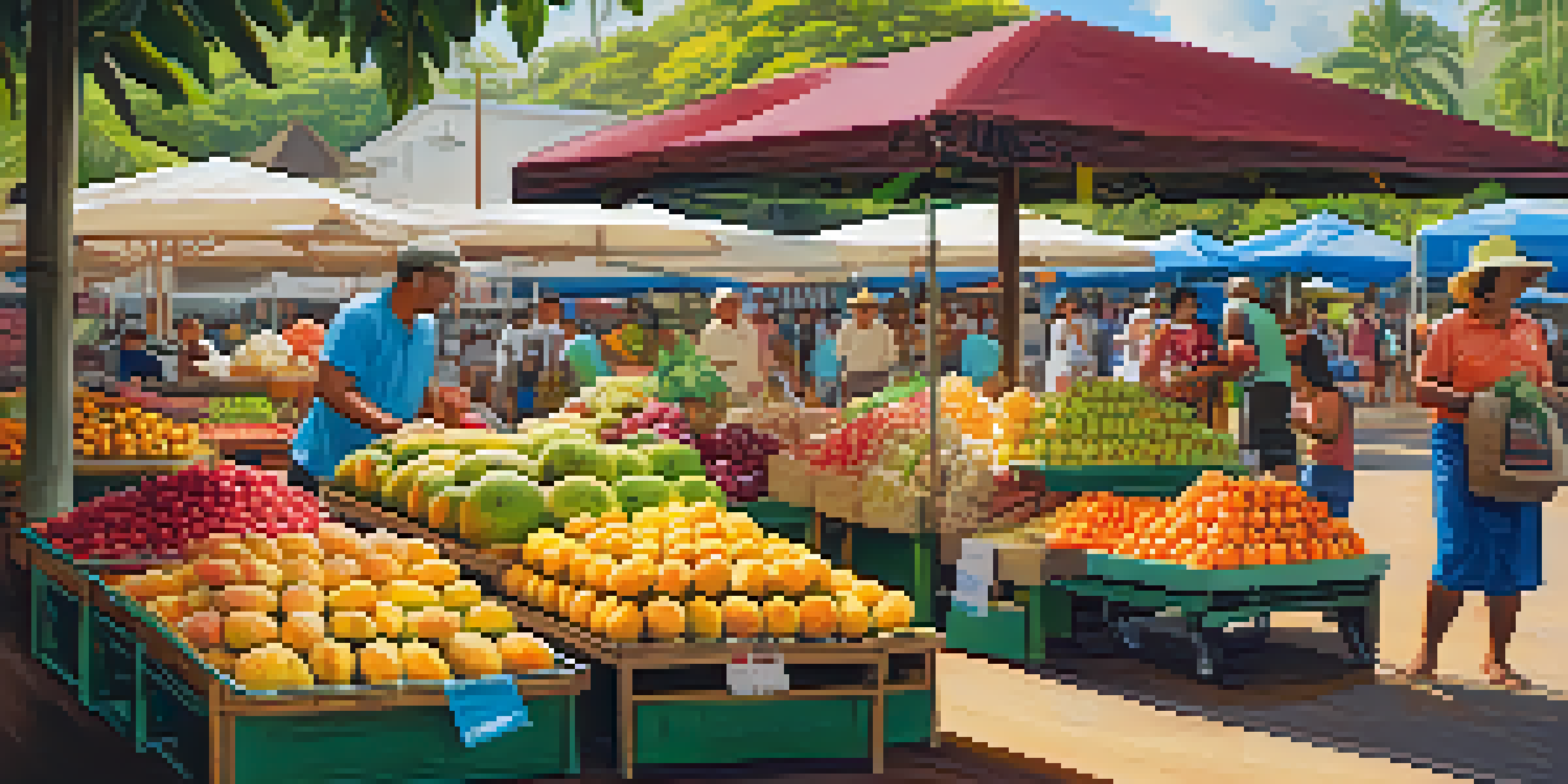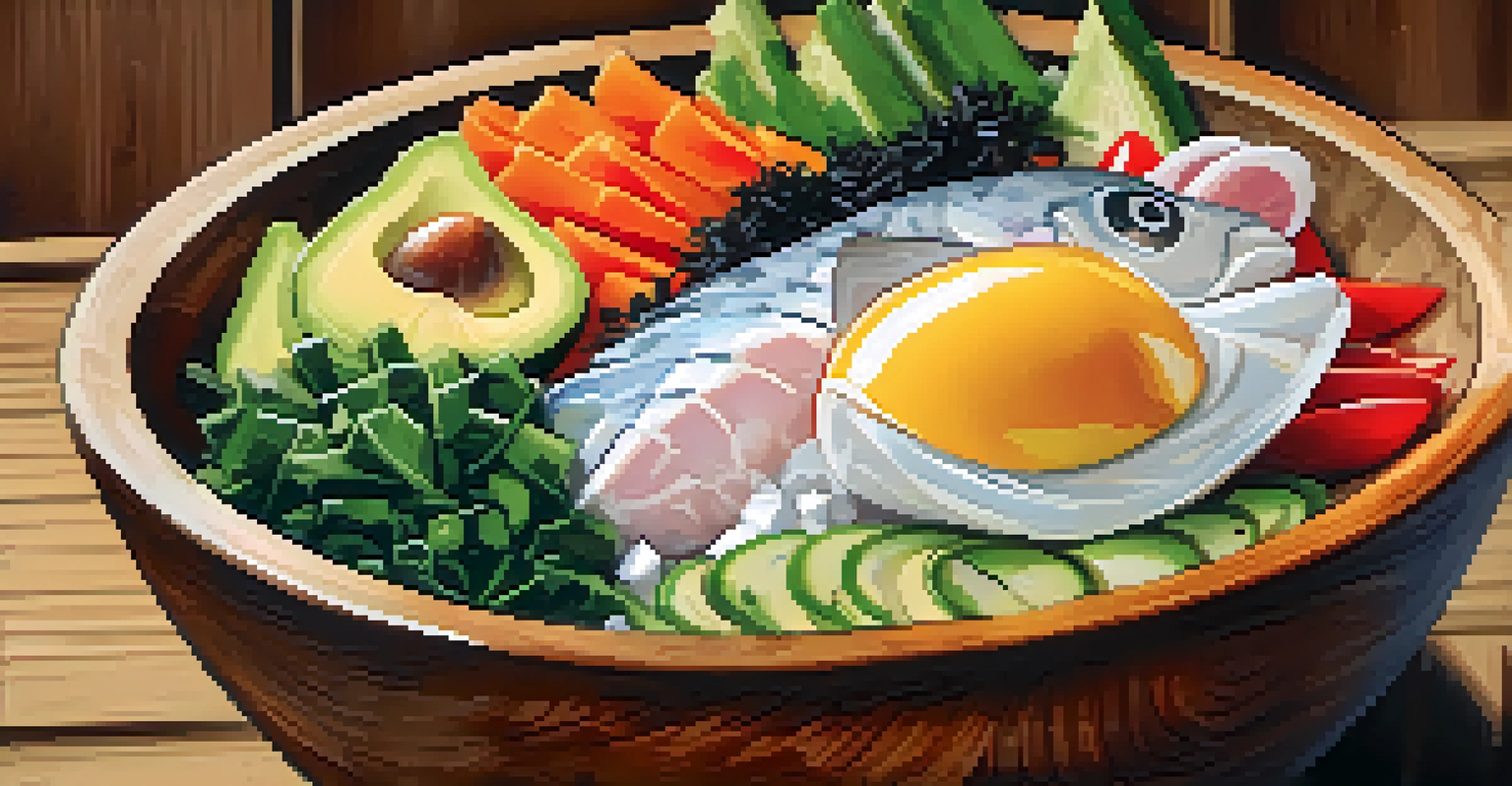Culinary Traditions: Food and Culture in Hawaii

The Unique Blend of Cultures in Hawaiian Cuisine
Hawaii's culinary landscape is a vibrant tapestry woven from its rich history and diverse cultures. The islands have been influenced by native Hawaiian traditions, as well as the cuisines of immigrants from Asia, Europe, and the Americas. This melting pot of flavors creates a unique gastronomic experience that reflects the islands' multicultural heritage.
Food is an important part of a balanced diet.
Traditional Hawaiian dishes often feature locally sourced ingredients, such as taro, fish, and tropical fruits. The use of these fresh, natural components not only highlights the islands' bountiful resources but also echoes the values of sustainability and respect for the land. For example, poi, made from taro root, is a staple that has deep cultural significance among native Hawaiians.
As you explore Hawaiian cuisine, you'll notice the influence of Asian flavors, particularly from Chinese, Japanese, and Filipino cultures. Dishes like poke, a raw fish salad, and loco moco, a rice dish topped with hamburger patties and gravy, showcase this fusion beautifully, inviting eaters to enjoy a slice of Hawaii's diverse heritage.
Traditional Ingredients that Define Hawaiian Flavor
The heart of Hawaiian cooking lies in its traditional ingredients, which are deeply rooted in the islands' history and environment. Staples like taro, sweet potatoes, and coconut are not only essential to the diet but also carry significant cultural meaning. For instance, taro is considered a sacred plant that plays a vital role in native Hawaiian mythology.

Seafood is another cornerstone of Hawaiian cuisine, reflecting the islands' close relationship with the ocean. Fish such as ono, ahi, and mahi-mahi are commonly used in various dishes, often prepared simply to highlight their fresh flavors. The practice of fishing is steeped in tradition, with many families passing down their fishing techniques through generations.
Cultural Fusion Shapes Hawaiian Cuisine
Hawaiian cuisine is a unique blend of native traditions and influences from various cultures, creating a vibrant gastronomic experience.
Tropical fruits like pineapple, mango, and papaya also play a significant role in Hawaiian dishes, adding sweetness and brightness to meals. These ingredients not only contribute to the flavor profile but also symbolize the islands' abundant natural beauty, making each bite a celebration of Hawaii's unique environment.
Influence of Native Hawaiian Culture on Food Practices
Native Hawaiian culture has a profound influence on the islands' culinary practices, emphasizing the importance of 'aina' (land) and 'kanaka' (people). This connection fosters a deep respect for natural resources, encouraging sustainable farming and fishing practices. Many traditional cooking methods, such as imu (underground oven), illustrate this relationship, showcasing how food preparation is intertwined with the environment.
The only time to be positive you've got a clear path is when you're on the edge of a cliff.
Gathering for a luau is a quintessential Hawaiian experience that highlights communal dining traditions. At these celebrations, dishes like kalua pig, cooked in an imu, are served alongside other local delicacies, creating a festive atmosphere filled with music and cultural performances. This sense of community is central to Hawaiian culture, as food brings people together.
Furthermore, the practice of sharing food is a vital aspect of Hawaiian hospitality, known as 'oha' (to share). This ethos encourages generosity and connection, with families often inviting others to partake in meals, reinforcing social bonds. The act of sharing not only enriches the dining experience but also embodies the spirit of aloha, a foundational value in Hawaiian culture.
Hawaiian Fusion Cuisine: A Modern Culinary Movement
In recent years, Hawaiian fusion cuisine has gained popularity, blending traditional flavors with modern culinary techniques. Chefs across the islands are experimenting with innovative dishes that celebrate Hawaii's diverse influences while incorporating global trends. This evolution showcases the dynamic nature of Hawaiian food and its ability to adapt and thrive.
For example, poke bowls have seen a rise in popularity beyond Hawaii, often featuring unique toppings like avocado or spicy mayo. This modern take on a traditional dish reflects the growing appreciation for Hawaiian flavors while appealing to a broader audience. Such adaptations highlight the creativity and ingenuity of chefs working to redefine Hawaiian cuisine.
Local Ingredients Drive Culinary Trends
The farm-to-table movement in Hawaii emphasizes the use of locally sourced ingredients, enhancing flavor and supporting local farmers.
The fusion movement also embraces local ingredients, often highlighting the importance of supporting local farmers and fishermen. By infusing traditional dishes with contemporary flair, these chefs are not only honoring their cultural heritage but also paving the way for the culinary future of Hawaii. This melding of old and new keeps the food scene vibrant and exciting.
Celebrating Local Ingredients: Farm-to-Table Movement
The farm-to-table movement has taken root in Hawaii, promoting the use of local ingredients in restaurants and homes alike. This initiative not only supports local farmers but also enhances the freshness and flavor of the dishes being served. By prioritizing seasonal produce and sustainably sourced seafood, chefs are creating meals that truly embody the essence of Hawaii.
Farmers' markets across the islands have become popular spots for residents and visitors to discover fresh, locally grown produce. These markets connect consumers with the farmers who cultivate the land, fostering a sense of community and appreciation for Hawaii's agricultural heritage. The vibrant colors and flavors found at these markets inspire countless culinary creations.
Moreover, the emphasis on local ingredients encourages a deeper understanding of the unique ecosystems present in Hawaii. Chefs often highlight lesser-known fruits and vegetables, such as ulu (breadfruit) or lilikoi (passionfruit), showcasing their versatility in a variety of dishes. This commitment to local sourcing not only elevates the dining experience but also strengthens the connection between food, culture, and the environment.
Cultural Significance of Hawaiian Food Festivals
Hawaiian food festivals serve as vibrant celebrations of the islands' culinary heritage, showcasing the rich tapestry of flavors and traditions. Events like the Honolulu Festival and the Maui Onion Festival bring together local chefs, farmers, and food enthusiasts to celebrate the unique ingredients and dishes that define Hawaiian cuisine. These festivals not only promote local food culture but also foster community spirit.
Attendees can indulge in a variety of dishes, from traditional favorites to innovative fusion creations, offering a delightful exploration of flavors. Demonstrations and cooking competitions often take center stage, allowing chefs to share their culinary expertise and passion for Hawaiian ingredients. This interactive experience engages participants and deepens their appreciation for the islands' food culture.
Food Festivals Celebrate Culinary Heritage
Hawaiian food festivals showcase the islands' rich culinary traditions, fostering community spirit and cultural expression through food.
Additionally, these festivals often include cultural performances, such as hula and music, making them a feast for the senses. By blending food with cultural expression, these events reinforce the idea that Hawaiian cuisine is not just about sustenance but also a celebration of identity, heritage, and community.
The Role of Food in Hawaiian Family Traditions
In Hawaiian culture, food holds a special place in family traditions, often serving as a centerpiece for gatherings and celebrations. The act of preparing and sharing meals is a way to express love and care, with recipes passed down through generations. These culinary practices create a sense of belonging and connection, reinforcing family bonds and cultural identity.
For many families, special occasions are marked by the preparation of traditional dishes that evoke memories and stories. Celebrations like birthdays, graduations, and holidays often feature beloved recipes, creating a tapestry of flavors that tell a family's unique story. This tradition of cooking together fosters a sense of unity and shared history.

Moreover, the emphasis on communal dining in Hawaiian culture encourages families to come together and share their experiences. Whether it's a simple weeknight dinner or a grand celebration, the act of breaking bread together strengthens relationships and nurtures a sense of community. In this way, food transcends mere nourishment, becoming a vital part of the Hawaiian way of life.